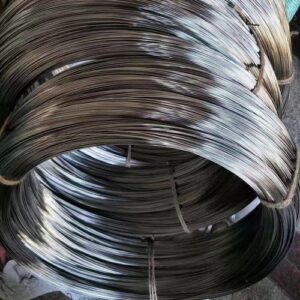Spring wire and Spring alloy wire

Elastic material is a basic material widely used in machinery and instrument manufacturing to make various parts and components. Its main functions in various machinery and instruments are: absorb vibration and impact energy through deformation, and ease the vibration of machinery or parts. And impact; use the energy stored during deformation to control the movement of machinery or parts; realize functions such as media isolation, sealing, and flexible shaft connection. The physical properties of elastic materials, such as elasticity, corrosion resistance, magnetic permeability, and electrical conductivity, can also be used to make instruments and meter components to convert physical quantities such as pressure, tension, and temperature into displacement, so as to measure or control these physical quantities.
1.Classification of elastic materials
1.1 Classified by chemical composition
Elastic materials can be divided into: carbon spring steel, alloy spring steel, stainless spring steel, iron-based elastic alloy, nickel-based elastic alloy, cobalt-based elastic alloy, etc.
1.2 Classification by use characteristics
According to the characteristics of elastic materials, they can be classified as follows:
1.2.1 General spring steel
(1) Deformation strengthened spring steel: carbon spring steel wire.
(2) Martensitic strengthened spring steel: oil-quenched and tempered steel wire.
(3) Comprehensive strengthening spring steel: precipitation hardening stainless steel wire
1.2.2 Elastic alloy
(1) Corrosion resistant high elastic alloy
(2) High temperature and high elastic alloy
(3) Constant elastic alloy
(4) Elastic alloys with special mechanical and physical properties
2 The main performance indicators of spring steel and elastic alloys
2.1 Elastic modulus
The steel wire deforms under the action of tension. When the tension does not exceed a certain value, the deformation is proportional to the external force, which is usually called Hooke’s law. The formula is as follows:
ε=σ/E
Where ε—strain (deformation size)
σ—stress (external force)
E—Tensile modulus of elasticity
Tensile modulus of elasticity (also known as Young’s modulus of elasticity or modulus of elasticity) is a measure of the difficulty of elastic deformation of metal materials. The modulus of elasticity of different brands is different, and the modulus of elasticity of the same brand is basically one. constant.
In engineering, in addition to the elastic modulus (E) that represents the ability of metal to resist tensile deformation, the shear elastic modulus (G) that represents the ability of metal to resist shear stress and deformation is often used.
There is a fixed relationship between tensile elastic modulus and shear elastic modulus: G=, μ is called Poisson’s ratio, the Poisson’s ratio of the same grade is a certain number, and the value of μ for elastic materials is generally 1/3~1/ Between 4.
E and G are two important technical parameters during spring design (the axial load force of the tension and compression coil spring is P=, the stiffness of the torsion coil spring is P=). The E and G values of cold drawn carbon spring steel wire and alloy spring steel wire are shown in Table 1.
Table 1 E and G values of spring steel
| Material Name | E(Mpa) | G(Mpa) |
| Cold drawn carbon spring(65Mn,70) | 196500~198600 | 78600~80670 |
| Cold drawn carbon spring(T8MnA,T9A) | 193000~203400 | 80000~82700 |
| 50CrV | 196500 | 77200 |
| 55CrSi | 203400 | 77200 |
| 60Si2MnA | 200000 | 74100 |
| 60Si2CrVA | 205800 | |
| 30W4Cr2V | 205800 | |
| 1Cr13Ni2(414) | 200000 | 77200 |
| 3Cr13(420) | 200000 | 77200 |
| 1Cr17Ni2(431) | 206000 | 77300 |
| 1Cr18Ni9(302) | 193000 | 68950 |
| 0Cr17Ni7Al | 203400 | 75840 |






